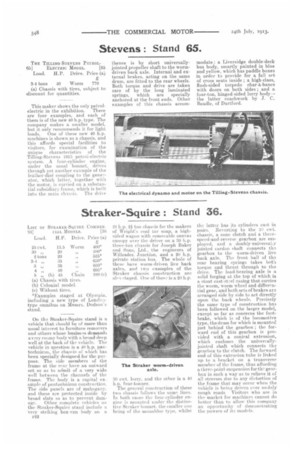Stevens : Stand 65.
Page 32

If you've noticed an error in this article please click here to report it so we can fix it.
THE TILLING-STEVENS PEZROL
65 ELECTRIC MODEL. [65
Load. H.P. Drive. Price (a) 3-4 tons 40 Worm 770 (a) Chassis with tires, subject to discount for cmantities.
This maker shows the only petrol
electric in the exhibition. There are four examples, and each of them is of the new 40 h.p. type. The company makes a smaller model, but it only recommends it for light loads. One of these now 40 h.p. machines is shown as a chassis, and this affords special facilities to visitors, for examination of the unique characteristics of the Tilling-Stevens 1913 petrol-electric system. A four-cylinder engine, under the usual bonnet, drives through yet another example of the leather-dis coupling to the generator, which letter, together with the motor, is carried on a substantial subsidiary frame, which is built into the main chassis. The drive thence is by short universallyjointed propeller shaft to the wormdriven back axle. Internal and external brakes, acting on the same drum, are fitted to the rear wheels. Both torque and drive are taken care of by the long laminated springs, which are specially anchored at the front ends. Other examples of this chassis accom
modate: a Liversidge double-deck bus body, smartly painted in blue and yellow, which has paddle boxes in order to provide for a full set of cross seats inside ; a high-class, flush-sided torpedo char-A-banes with doors on both sides ; and a four-ton, hinged-sided lorry body— the latter coachwork by J. C. Beadle, of Dartford.








































































